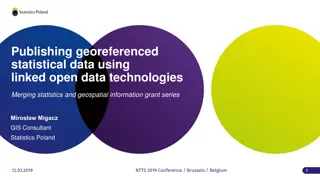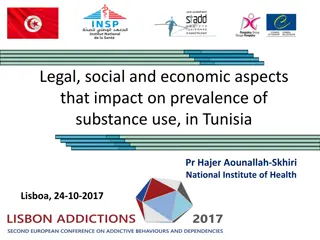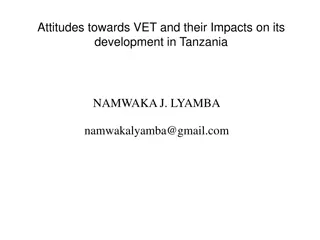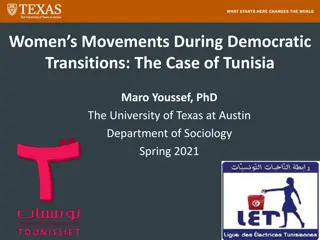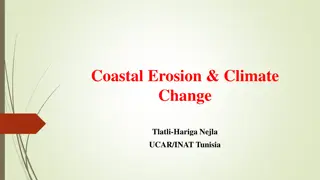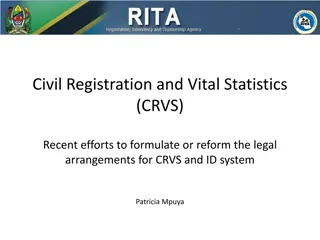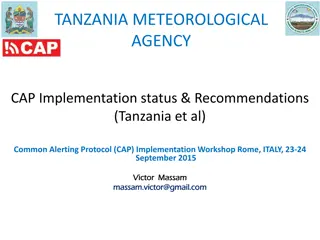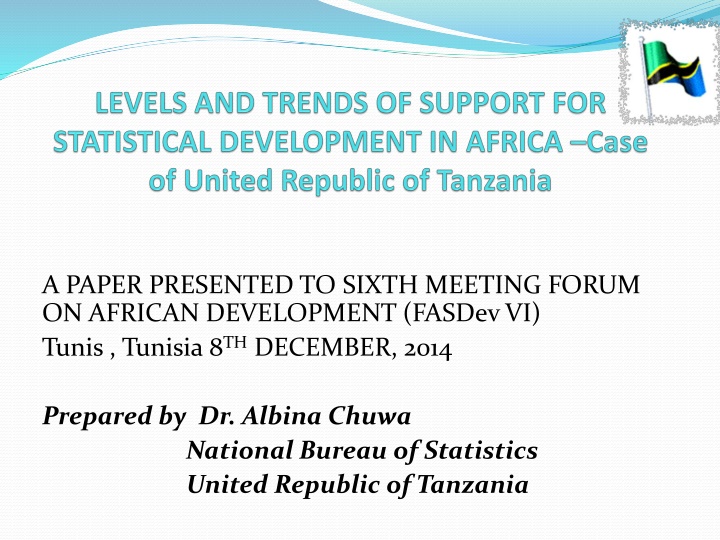
Strengthening Statistical Development in Tanzania: TSMP Implementation Overview
Explore the comprehensive framework of the Tanzania Statistical Master Plan (TSMP) aimed at enhancing the National Statistical System (NSS) to produce quality statistics for informed decision-making and policy monitoring in Tanzania. Learn about the key components, challenges, and the way forward outlined in the presentation delivered at FASDevVI.
Download Presentation

Please find below an Image/Link to download the presentation.
The content on the website is provided AS IS for your information and personal use only. It may not be sold, licensed, or shared on other websites without obtaining consent from the author. If you encounter any issues during the download, it is possible that the publisher has removed the file from their server.
You are allowed to download the files provided on this website for personal or commercial use, subject to the condition that they are used lawfully. All files are the property of their respective owners.
The content on the website is provided AS IS for your information and personal use only. It may not be sold, licensed, or shared on other websites without obtaining consent from the author.
E N D
Presentation Transcript
A PAPER PRESENTED TO SIXTH MEETING FORUM ON AFRICAN DEVELOPMENT (FASDevVI) Tunis , Tunisia 8THDECEMBER, 2014 Prepared by Dr. Albina Chuwa National Bureau of Statistics United Republic of Tanzania
PRESENTATION LAYOUT Profile of the United Republic of Tanzania Background of Statistical Development NSDS -TSMP Budget and Source of Funding Implementation of TSMP Key activities conducted by components Results of the Program Challenges and The Way Forward
TANZANIA MAP Tot. Population = 46 million people Economic growth of 7.0 Percent. Inflation Rate =5.8 Percent Land Area =945,087 Sq. Kms.
Background The Busan Action Plan for Statistics provides a useful framework through which statistical capacities can continue to be developed. This plan emphasizes the role of National Strategies for Development of Statistics (NSDs), a strategic approach bringing together and coordinating between the different data users and producers of official statistics within NSS. The Marrakesh Plan of Action back to year 2004 and other African Actions including SHAsA, African Charter on Statistics emphasizes on the production of quality statistics that will carter for coherence and comparability internationally
Background Economic structural and institutional reforms aiming at improving socio-economic development in order to improve the livelihood of the people, quality statistics is very crucial to inform evidence based decision making at all levels. Based on Results Based Management, The Government of Tanzania endorsed NSDS commonly known as Tanzania Statistical Master Plan TSMP in 2010. It is a five years Plan ( 2011/12 2016) which sets a comprehensive framework aiming at strengthening the National Statistical System (NSS) in Tanzania
Background The developmental objective of TSMP is to strengthen the NSS in Tanzania to produce quality statistics for planners, decision makers, private sectors and public at large and for performance monitoring of national polices as well as Millennium Development Goals (MDGs).
NSDS -TSMP Components -Implementation TSMP focused on the following components: 1. Institutional Development and Legal Reforms, 2. Human Resource Development EASTC Training Centre for Official Statisticians (NSS), 3. Development of Statistical Infrastructure, 4. Data Development and Dissemination, 5. Physical Infrastructure and Equipment and 6. TSMP Coordination team for day to day activities.
TSMP Budget and Source of Funding For a period of 5 years (2011/12 2015/16) a total budget of USD 64.4 million was set aside and the main source of funding is from Government Subvention, STATCAP Loan WB and other development partners who contribute through a Basket Fund and managed by NSO. (Different Operational Manuals Procurement, Financial, common M&E frame work) have been developed
Implementation of NSDS -TSMP Implementation of TSMP is based on Annual Work Plan and Monitoring and Evaluation Framework prepared in a consultative manner with four sector working groups (Macro, Social, Agriculture, and Good Governance). The annual plan is endorsed by TSMP Joint Steering Committee ( Government and DP s) embedded in the organization structure of NSO; Priorities are set by NSO based on the National Development Framework Indicators in collaboration with Sector working Groups and some times through a strong dialoque between users and producers of those indicators (relevance and impartiality, coherence and comparability of indicators) Work progress is reported on Quarterly and Annual basis
Results of the Program Legal Reforms and Institutional Development; Enactment of 2013 Statistics Bill that will provide professional autonomy of NSO, define clearly NSS and its role and human development common cadre of official statisticians in the NSS This Statistics Bill will address all proposals contained in the African Charter on Statistics Strengthening Routine Data System in Tanzania MDA s : Signing MoU s with MDA dealing with production of agricultural statistics- common standards and methods, (compendium has been developed and being implemented Global Strategy for improvement of Agriculture and rural statistics) Agriculture Statistics Strategy Plan has been developed (five year plan to improve agriculture routine data system in Tanzania in terms of human development EASTC has introduced a Master Degree in Official Statistics Component of Agriculture (Agricultural Extension Workers) that will kick start January, 2015 in collaboration with Ministry of Statistics and Programme Implementation of the Government of India. Currently under this component EASTC has different students from NSO s from Ghana, Nigeria, Sierraleone, Rwanda, Ethiopia, Swaziland, Uganda, Zambia and Tanzania, Somali Land.
Results of the Program Indicator(s) Base line Milestones 2014/2015 Implementation Status by year ending June,2014 Goal: To strengthen the National Statistical System in Tanzania to produce quality statistics for decision makers in an objective, timely and cost effective manner 1.Satisfaction Index from User Satisfaction Survey. Measures satisfaction of users with National Statistical System products across a number of dimension 2013/14 USS overall score was 3.5 out of 5 equivalent to 70 percent. 3.53 out of 5 3.7 out of 5
Other Important Results Indicator(s) Base line Milestones 2014/2015 Implementation Status by year ending June,2014 Intermediate Outcomes: Improved sampling frames; Harmonized statistical concept and definitions; Development and effective usage of spatial data systems 1.Comprehensive revision of Business Register at least every 3 years, annual updates for larger firms In Tanzania it was updated 2010/11 To have another Comprehensive Update 2014/15 Routine update 2. Development of Geo-Spatial Data GIS Using 2012 Population and Housing Census - Water Points, Health Facilities in the Country Very useful in the Open Data Initiative Transpareny,
Other Important Results Indicator(s) Base line Milestones 2014/2015 Implementation Status by year ending June,2014 Intermediate Outcome: Improved data production, coordination, dissemination and access of micro and metadata to various users. 1. Full and timely implementation of census and surveys specified in the Inter-censal Survey Calendars Number of data sets uploaded to the National Data Archive (NADA) WB Software ADP have increased up to 75 percent Reduction of conflicting data collected from different sources
What impact TSMP has brought within the NSS Conducting Annual National Peer Reviews since 2011 which called upon Users and producers to comment on the quality and services rendered by NSO and (receive self reflection) Challenges and the way forward Implementation of national Surveys as per calendar has been possible due to availability of resources Dissemination and utilization of Statistical Activities has raised the profile of NSO
What impact TSMP has brought within the NSS Through User Satisfaction Survey, stakeholders perception about services provided by NBS and OCGS have been enhanced Access of micro data for other wide use across national and international agencies has been eased and available in NADA via NBS Website www.nbs.go.tz
What impact TSMP has brought within the NSS Number of MDAs working with NSO has increased The 2014 Mid Term Review revealed the efficiency and effectiveness of NSDS TSMP in Tanzania and recommended to consider Second generation of the NSDS as we are moving towards post 2015 Development Agenda DATA REVOLUTION
What are the Challenges and Way Forward NSDS s would need new priorities and to be backed with more financial investment. This call upon international community to agree on common global statistical strategy and a global partnership to co-ordinate and deliver ( respond to the Data Revolution Political will and good leadership at national level Financial Autonomy (establishment of the Statistics Fund or Basket Ring fenced) at the national level
END Thank you for your kind attention







